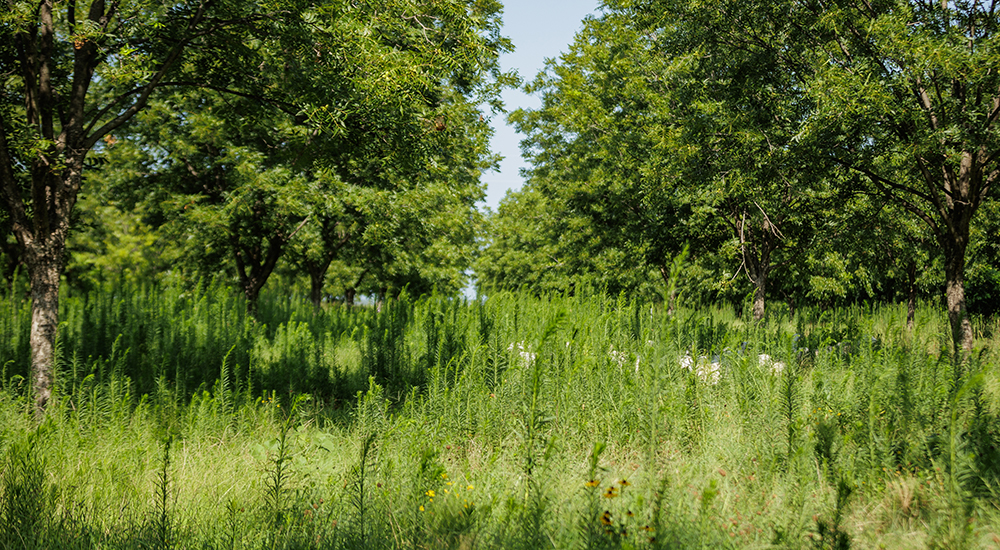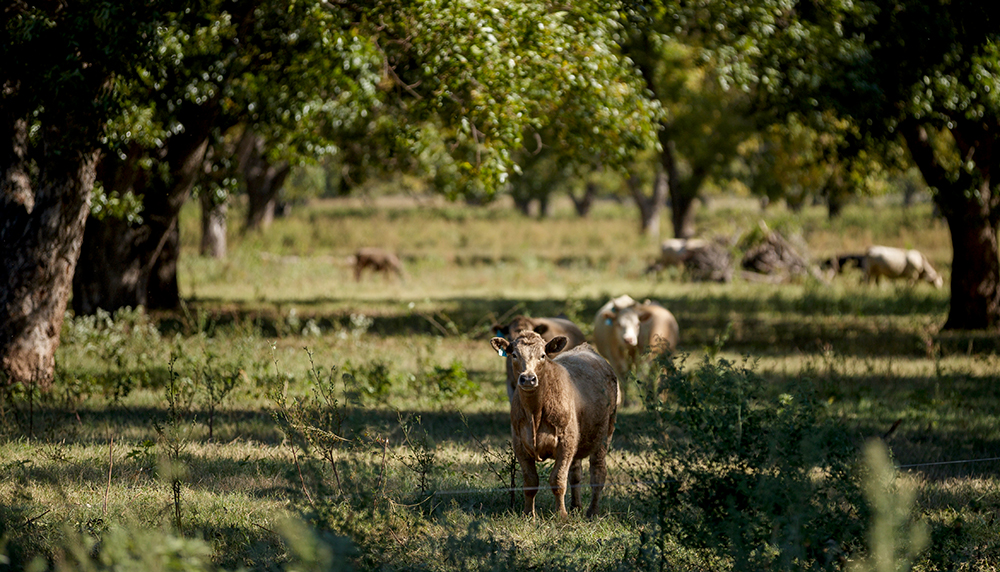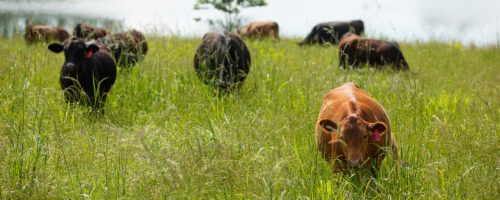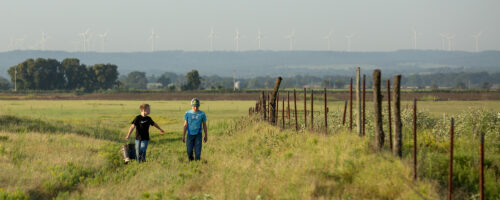Getting Started With Silvopasture Using Soil Health Principles
Integrating trees such as a pecan orchard with your grazing system adds biomass to soil, shade for livestock and potential new income for your ranch.
Somewhere between a rural Oklahoma ranch upbringing and his pursuit of a Ph.D. in crop production, Charles Rohla had an ah-ha moment that would shape the rest of his career.
“I realized, money actually can grow on trees,” he recalls with a laugh.
After earning degrees in animal science and agriculture education, Rohla began work at an Oklahoma State University research station, where pecan production piqued his interest.
“That was where I really tied those two things together – that you could raise livestock and trees, producing two valuable crops on the same land,” he says.
He’s spent the past 17-plus years on staff with the Noble Research Institute combining these two passions into a career researching silvopasture – the deliberate integration of livestock and trees, in particular, pecan trees. As Noble has transitioned its mission to regenerative ranching research, Rohla is once again witnessing a revolution in thinking. The nuts growing on the orchard trees might provide the money that makes the cash flow, but the true value is actually growing in the soil bank below.

FOLLOW SOIL HEALTH PRINCIPLES
Historically, Americans have separated livestock raising from timber or orchard production due to ample land availability, but Rohla says bringing the two back together makes a win for people, profit and planet.
“Most producers are wanting to know, what practices do I need to do, what steps do I need to take, when they start to consider adding this kind of enterprise,” Rohla says. “But there is no prescriptive practice – you have to really train yourself to read your land, read your trees, read your livestock, and really think about how it all intertwines. It’s not about implementing practices, it’s about following principles.”
Adding trees to a grazing system may seem counterintuitive if the focus is maximizing grass production by reducing any or all ‘competition,’ but soil health principles point to the value of adding diversity above and below ground, and to maintaining living roots in the soil. With proper tree spacing – Rohla recommends no more than 50% shade in a tree grove – he says you’re not likely to give up any forage production, and you may, in fact, increase it.
The presence of deciduous trees adds biomass to soil as fallen leaves and small branches decompose. Rohla says some studies point to increases of as much as 30-50% in soil organic matter in tree-covered grasslands compared to open pasture.
Deep, perennial roots help water sink into the soil and hold moisture, and the shade canopy can extend cool-season grass production in late winter and early spring. For livestock, the shade offers heat-stress relief and can increase grass’s palpability and nutritional density.

HOW TO GET STARTED
If you’ve considered adding a tree-based enterprise – whether it’s for timber, nuts or fruit production – to a livestock grazing enterprise, start with soil health principle No. 1: context.
Get to know what – if any – trees will flourish in your region, and on your particular land. Consider what trees occur naturally, or research what may have historically been cultivated in your region. Most fruit and nut trees prefer well-drained, loamy soils, and will not tolerate high water tables.
Next, keep an open mind concerning the livestock that will fit with the right trees. Almonds are relatively smaller trees, making smaller ruminants perhaps preferrable over cattle. Sheep and goats are known to ‘de-bark’ trees if they’re seeking certain minerals or are short on other forage, which points toward cattle when growing large trees that provide ample space for them. Hogs might be the right fit for forested timber that doesn’t require harvesting an edible product off the ground.
For pecans, Rohla says, 30-40 acres of trees is generally the minimum amount to justify the purchase of your own harvesting equipment. Less acreage is fine, but calculate the cost of hiring custom harvesters, too. Pecan orchards can be planted as densely as 35 trees per acre, but once they start to grow, thin trees to maintain the 50% shade goal. Pecan trees take seven to eight years to start small production, and full production doesn’t typically come to fruition until years 12 or 13. It’s a slow build, but the trees can also stay in production for hundreds of years.
This long-term view is another strength of a silvopasture system.
“The pecan grower is planting a crop for their children, grandchildren and great-grandchildren,” Rohla says. “The livestock in the system provides a near-term revenue driver until the pecans start production and an additional revenue stream during years of low production.”
Tree leaves can be high in protein and minerals, making them a tempting food source for livestock. Plan to protect young, small trees by fencing around them individually. When using high-intensity grazing, exclude entire tree rows from the paddocks to protect trees while concentrating grazing between the rows. Removal of livestock prior to harvest is required in many tree crops, so a grower should check with their state agricultural department and their buyers to determine length of withdrawal time.

WORK, AND WATCH IT GROW
For livestock grazers considering adding a tree-based enterprise, the biggest barrier may be the start-up time and capital needed to cultivate the orchard and nurture it through the pre-income growth years. For silviculturists considering adding livestock to their established orchard’s management plan, it takes a commitment of time and energy (and infrastructure) to manage those live animals well.
Still, Rohla says, the enterprises in combination work for the benefit the entire system.
In 2023, Noble launched the Pecan Strategy Research Project to assess soil health, ecosystem resiliency and profit per acre across a continuum of orchard management systems. Through this work, Rohla says they’ll continue to add data to anecdotal evidence of the value of regenerative silvopasture systems he has observed and studied throughout his career.
He points to one of the Texas producers in the research project who, in many ways unknowingly, has taken a principled approach toward soil health in his silvopasture. After several years of selectively grazing cattle in the orchard, the grower marked an increase in weaning weights, which he attributes to reduced heat stress and heightened nutritional availability. He’s planted cover crops between non-irrigated trees to create a layer of moisture-capturing thatch. The cattle can be used to graze and trample the cover crop, now eliminating the need for costly chemical termination.
“In a year of drought all around him, you could dig under that layer of thatch in the orchard and still make a mud ball. Those cover crops were holding that much moisture in the ground,” Rohla says. In years where poor weather conditions resulted in an industry-wide poor pecan crop, this orchard continued to produce above-average pecan yields and quality.
“It’s not easy, and it’s not a deal where you just plant a tree, walk away, and hope to come back in seven or eight years for the harvest,” Rohla says. “It takes time, hard work, and you have to be intentional in your management of the trees, the animals and your soil.”
For more about silvopasture and other agroforestry, see The Silvopasture Approach to Regenerative Agriculture.


Comment
Leave a Reply
1 comment on: "Getting Started With Silvopasture Using Soil Health Principles""

Wanda Shiplett Dooley
September 26, 2023Good information . Thank you Wanda